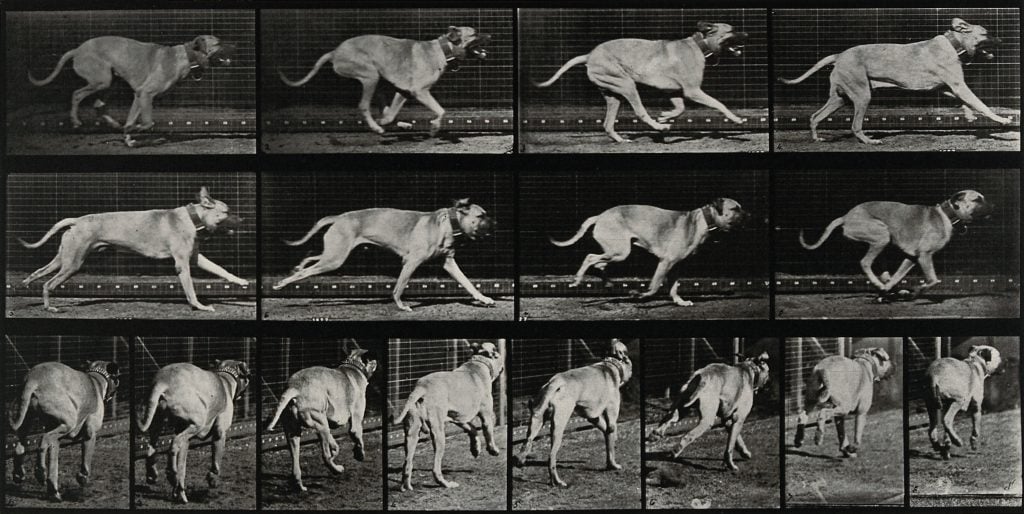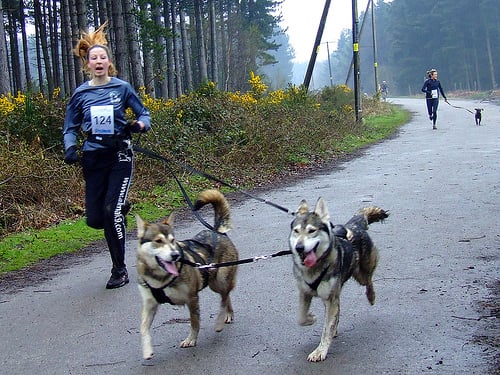Have you ever raced your dog through the yard, or watched them run neck-and-neck with a canine pal at the park? Some dogs can really run! But not every dog runs in the same manner, or at the same speed.
How fast the average dog can run depends on breed and body composition. Low-slung, short-legged breeds like Basset Hounds and Dachshunds are a lot slower than long-legged runners like Greyhounds and Whippets.
From the slowest dog breeds to the fastest dog breeds, here’s everything you need to know about dog running speed.
How Do Dogs Run?

A dog running by Eadweard Muybridge, via wikicommons
How fast the average dog can run depends on their body composition and breed. However, all dogs share some qualities that make them potentially good runners:
- Feet that can grip and feel the ground, plus nails for traction, giving dogs great turning ability and complex gaits (source).
- A double-suspension gallop that maximizes speed and distance when running at top speed.
- Lots of power and forward drive thanks to their flexible spine, long loins, and strong abdominal muscles.
When they run fast, or gallop, dogs have a four-time, asymmetrical gait. This means that as they run, their feet fall in a pattern of right front, left front, right hind, left hind (source). Each front foot lifts off the ground before its corresponding rear foot steps down. Some fast breeds have a double-suspension gallop in which their body is propelled through the air with four legs leaving the ground at the same time.
In general, dogs can run about 15–20 miles per hour for short distances. However, some breeds are a lot slower than that, while others are capable of much faster speeds. A dog’s speed depends on their physical composition, breed, and health.
Some Dogs Run Fast, Really Fast
Imagine the fastest-running dog in the world. You’re probably picturing a greyhound! Greyhound dogs can run up to 45 miles per hour, rivaling the cheetah for land speed records over distance (although cheetahs beat them handily in a sprint).
Other leggy hounds can run at similarly fast speeds. Salukis, Vizslas, and Deerhounds have all been clocked around 40 mph. German Shepherds and Border Collies can run up to 30 mph. Boxer dogs can run that fast, too, and were used as couriers in wartime thanks to their running abilities (source). And even some smaller, athletic dogs like Jack Russell Terriers and Italian Greyhounds can reach speeds of 25–30 mph!
What do these fast dogs have in common? A deep chest, lean body, and proportionally long legs. They have the cardio power and lung capacity to move fast, and a wide reach to keep them covering ground.
In general, these fast-running dogs are timed at a sprint. That means they’re running in short, quick bursts at speeds they can’t maintain over distance. But how fast can a dog run a mile? Well, dogs with the stamina to maintain speed over time can do an easy mile in five or six minutes, or even less. In 2016, a Weimaraner and his person set a record for running a mile in four minutes and thirteen seconds!
For more on speedy breeds, read our post on the fastest dogs in the world.
Other Dogs Run Slowly

via wikicommons
We can’t all be greyhounds. Most dogs top out at an average of 19 mph, significantly slower than their long-legged cousins.
Extra-small breeds like Chihuahuas are slow because of their size; their legs simply don’t move far or fast enough! Short-nosed dogs like Pugs and Bulldogs can’t run fast because their breathing can’t keep up. And extra-large breeds like St. Bernards and Newfoundlands are slower because of their mass. They may be able to exert a quick, fast burst of energy, but they likely won’t keep up with you in a foot race.
Some slower dog breeds (and their estimated speeds) include:
- French Bulldog (under 15 mph)
- Shih Tzu (6 mph)
- Pug (5–10 mph according to some sources)
- Toy Poodle (10 mph)
- Bulldog (under 15 mph)
- Bassett Hound (5–10 mph)
Of course, speed is relative. While a Pug may look slow next to a Greyhound, they can still race each other around a yard in short bursts. Which brings us neatly onto…which dogs can run, and run, and keep running for miles on end?
Endurance Runners

via wikicommons
What about dogs who run for long distances? While their top speed may not seem impressive compared to a racing hound, dogs with endurance are capable of maintaining speed over longer periods of time. These breeds tend to make excellent running partners for humans who like to move.
Dog breeds who can distance run include:
- Labrador Retriever
- German Shorthaired Pointer
- Siberian Husky
- English Setter
- Standard Poodle
- Dalmatian
These breeds and similarly sized dogs can manage consistent 10–15 mph runs, which is quicker than 6 minute-per-mile pace–still pretty speedy! Just picture a sled team of Huskies in a multi-day race: they’re not sprinting the whole time, but they move consistently over a long course. That’s some impressive athleticism.
Of course, if you have a beloved mixed-breed dog, you may find that they fit into any of the above categories depending on their body shape. Age and health have a lot to do with how fast a dog will run, as well. Younger dogs tend to have more drive, whereas older pups may develop arthritis and injuries that slow them down.
Whether your dog is a sprinter, distance runner, or a slow trotter, all dogs need exercise. Thankfully, there are plenty of options to use your dog’s natural running abilities. Hiking, jogging, walking and bike riding are all great options to avoid the consequences of an under-exercised dog.





